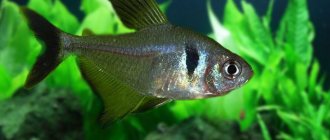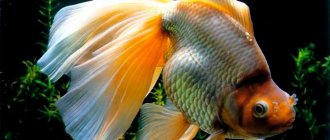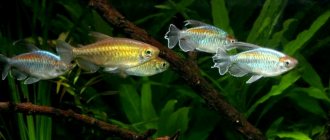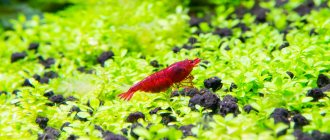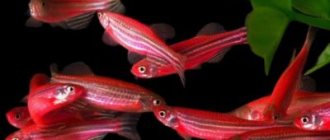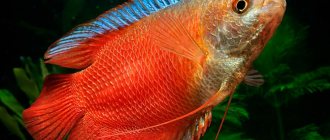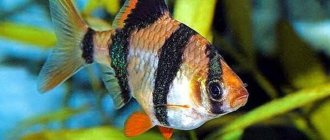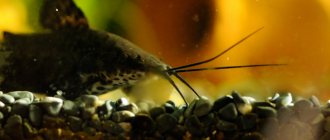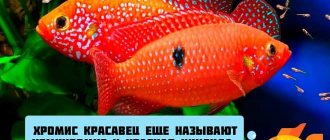Acantophthalmus Kühl is an amazing and unusual fish from the loach family, attracting aquarists with its special, incomparable beauty. They call it a variety of names: pangio, spotted prickly eye, acanthus, snake, but the most common nickname is traffic cop, because the black transverse stripes on the long snake-like body resemble the baton of a traffic policeman. The species was first described in 1846 by Valensis.
Külya lives in an aquarium for about 5 years
Description of the fish
Acantophthalmus Myers has its own distinctive features in body structure and behavior.
Appearance
Nature gave Myers a peculiar body. Thanks to its distinctive feature, the fish became like a snake.
In addition to its length, the body is characterized by its shape - it is flattened on both sides in the tail area. When kept at home, the length of the fish does not exceed 12 cm. On the small head near the mouth there are 3 pairs of sensitive whiskers. With their help, loaches feel for food.
The fins are small, transparent, the back is located closer to the tail. The body is covered with small scales. Under the eyes there are forked spikes.
Body color can have 2 shades: red or orange. Dark stripes run across the surface. Depending on the age of the fish, their number can vary and reach up to 20.
Sexual dimorphism is pronounced. Males are smaller than females. Females have a more convex abdomen, through which you can see the eggs, colored greenish.
Appearance of Acantophthalmus Myers
Lifestyle
Underwater inhabitants are predominantly nocturnal, and it is at this time that their activity peaks. And during the day they sleep sweetly, curled up among the thickets. Some individuals burrow into the ground or hide under snags. They are considered peaceful fish.
Due to the fact that acanthophthalmus are not gregarious, they can be kept alone. However, loneliness has a negative impact on quality of life. When keeping 4-5 fish together, greater activity is observed.
Behavior
As noted earlier, acanthophthalmus are peace-loving fish that cannot harm anyone. They lead a predominantly bottom-dwelling lifestyle. They are loyal to their neighbors. When breeding snake-like fish, the aquarium is allowed to be filled with vegetation. Decorative plantings will not suffer from the sharp teeth of acanthophthalmus, since the fish are indifferent to plants.
Lifespan
If good conditions are created, aquarium snakes can live up to 10 years or more.
Interesting features
Acantophthalfus is notable not only for its serpentine body, but also for a number of other interesting features:
- The fish has several types of respiration - through the skin and using the air supply in the stomach. She gains it by periodically rising to the surface of the reservoir.
- Acanthus are true barometers of atmospheric pressure. When it fluctuates, they gather in flocks and actively move in different layers of the reservoir, although in a calm state they prefer a bottom lifestyle. This is explained by the peculiarity of the air bubble located in the body of the fish in a special bony shell.
- The spikes under the eyes look very unusual, but have a useful function. They help the fish make its way through thickets of aquatic plants. Acanthus, turning its head, clings to the grass with its shoot and pulls up its body. In addition, this is a serious and very sharp weapon. If a large fish swallows an Acanthus, the latter is capable of cutting through the stomach of the predator with its spines, killing the hunter and getting out to freedom.
- Acanthus are great at hiding. During the day they are difficult to find in the aquarium - they expertly bury themselves in the bottom filler or hide among thickets of algae and decorations, curling up into balls.
Aquarium
Due to the fact that the aquarium fish Acanthopthalmus leads a bottom-dwelling lifestyle, the shape of the aquarium should be rectangular or square. Round tanks are not suitable for fish with a snake-like body, as they do not contain enough usable space.
If you plan to breed 5-6 acanthophthalmus, then this amount will require 70 liters.
The reservoir must be covered with a lid or mesh. The safety of pets depends on this. The lid will prevent them from jumping out of the water and dying unattended.
However, the violent temperament of fish does not always require the creation of cover. Loaches are real barometers, and when they begin to sense changes associated with atmospheric pressure, they begin to swim chaotically throughout the aquarium. Often such activity leads to the fact that the thorns, as they are also called, jump out of the water and break into nearby objects.
Aquarium with acanthophthalmus
Water parameters
The optimal temperature for breeding acanthophthalmus varies from +22°C to +28°C. At low temperatures, individuals get sick. Hardness level – 5 dH, acidity – 6.5 pH.
Small and adult inhabitants are sensitive to water indicators; if they don’t like something, they float to the surface. This behavior is not typical for this species, since acanthophthalmus prefers a bottom lifestyle.
Plants
Since fish need dim light, it is advisable to fill the aquarium with thick algae. Acantophthalmus are nocturnal, at this time light is not important to them, but during the day the algae will serve as cover from bright light. Java moss, tiger water lilies, and Thai ferns are suitable for planting.
Behavior
Bug-eyes are very active at night, they are constantly on the move and search for food, tearing up the ground.
Fish love company, so it is recommended to house them in groups of 5-7 individuals. They spend a lot of time together and only in a flock they are not shy and self-confident. Therefore, if you place one or two fish, you will only be able to see them at night, when they swim out of hiding.
Acantophthalmus culea has a reputation as a weather predictor. They sense changes in atmospheric pressure. When it changes, loaches become especially active and swim in all layers of water.
Pangios get along well with small fish that live in the middle and upper layers of water, and get along well with shrimp. But large crustaceans and predatory fish will regard them as food.
Kinds
Today you can find several varieties of these fish that are successfully kept in the aquarium. Acanthopthalmus species differ mainly in color, but they also have other features. So, today you can find the following types:
Acanthophthalmus culea fish
Visually resembles a flattened snake. It has a pink-yellow color, grows up to 10 cm. There are small fins along the body, and three pairs of whiskers are located near the mouth. Up to 20 dark brown stripes are scattered throughout the body. Leads a nocturnal and bottom-dwelling lifestyle typical of its family. The conditions of detention are no different;
Acantophthalmus Myers
In many ways it has similarities with the previous species. But its main feature is its smaller size and color. The body is orange with black or dark brown stripes. There are scales on the head. The fins are poorly developed and do not have sharp ends;
Acantophthalmus semi-girdled
It is sandy in color with dark stripes. There are no scales on the head. The eyes are small and have a thin film that serves for protection. They are also “armed” with spines, thanks to which the animal resists predators. The dorsal fin is slightly displaced.
Origin
The name of the fish - Pangio Acanthophtalmus - is translated from Latin as “torn eyes”. It was derived from the presence of spikes on the fish's head, which gave the eyes the appearance of having no outline. The unusual appearance has long raised doubts among biologists: what class should Acanthophthalmus be classified into?
The species was first described by scientist Valensis in 1846. They began actively breeding fish as a pet in Russia only in the seventies of the last century.
Habitat in nature
The species lives in Southeast Asia: Sumatra, Borneo, Singapore, Malaysia, Java. It prefers to settle in bodies of water with a small current or stagnant water, with a bottom covered with a dense layer of leaves. It lives among forests, so it is accustomed to living in the shade of spreading tree crowns.
Feeding
Despite the fact that Acanthus are not a predatory species, they are omnivorous - they absorb any type of live, frozen, dry and plant food that sinks to the bottom.
They love bloodworms, tubifex, daphnia, artemia nauplii, echytraea, cyclops, small snails, spirulina tablets. Occasionally it is necessary to provide food with natural carotenoids to enhance the color of the fish. It is advisable to pre-disinfect live food in an Ichthyphora solution so as not to introduce infection into the aquarium. Frozen ones are not dangerous in this regard, but some proteins, fats and carbohydrates are lost.
In addition, Acantophthalmus are good tank cleaners, as they happily eat leftover food from other fish and are able to dig them out of the ground.
Feed 3-4 hours before dark at night. Food should be eaten within 4-5 minutes, portion sizes should be limited.
Feed
Acanthophthalmus myers's favorite food is tubifex. Consumes any small live food, tablets for bottom fish. It is advisable to include greens in your diet: cabbage, lettuce, etc. It feeds only from the bottom, so care must be taken to deliver food to the lower layer, bypassing the other inhabitants of the aquarium.
Video. During feeding:
Acantophthalmus are terrible gluttons and easily suffer from obesity. Therefore, once a week it is mandatory to arrange a fasting day for them.
Reproduction of acanthophthalmus
Spawning occurs during the rainy season. Rare cases of reproduction of Kühl fish are known in captivity. To create favorable conditions for breeding, you first need to buy a huge aquarium. It is possible that hormones will need to be administered.
The difference between a female and a male
Dimorphism is pronounced. Females and males reach sexual maturity by 12 months. The body of the female is 2 cm longer than the body of the male, the abdomen is more rounded and large.
Female and male acanthophthalmus
To obtain offspring, it is recommended to carry out a number of actions:
- first you need to buy a spawning tank - a tank with a volume of at least 1000 liters;
- fill the tank with water no more than 20 cm in height;
- you will need to plant living plants, both rooted in the ground and self-floating;
- It is recommended to cover the bottom of the tank with a separator mesh;
- care must be taken to create dim lighting;
- check the water for compliance with the following parameters: hardness, acidity and temperature.
Conditions for keeping
Keeping fish includes compliance with certain standards and actions for their care:
- have a 50-liter aquarium or more;
- feed the fish daily;
- maintain the filter, compressor, thermostat, lighting, soil, greenery in working order with the required parameters;
- cover the aquarium with a lid to prevent the spiny eye from jumping out of the water;
- keep the water and soil clean.
Since the trivial and persistent aquarium fish Acanthus Kühl has no scales, its sensitivity to medications and food breakdown products (ammonia, nitrates) is increased
Fish should be treated carefully and the soil should be cleaned regularly
How many individuals in one aquarium
One acanthus is practically invisible in the aquarium. During the day it will burrow into the ground, and at night it will begin to actively search for food. But a flock of six individuals will force them to leave their shelters and compete for food during the day.
The number of fish depends on the volume and bottom area of the aquarium: try to purchase one with a larger bottom area, since acanthus are bottom-dwelling fish.
Did you know? In its natural environment, Kühl's acanthophthalmus uses its spines to rip open the stomach wall of the fish that has swallowed it, sometimes successfully!
Aquarium volume
A 70-liter or more aquarium is suitable for six representatives of Kühl's acanthophthalmus. Let's repeat about the presence of a lid for the aquarium.
Spiny eyes adapt well to a medium-sized aquarium with a soft, acidic water environment and low lighting.
Find out how to determine water hardness and the optimal water temperature in your aquarium.
Water
Water temperature indicators correspond to the norms of +26-30°C, water acidity (pH) is 5.5-6.5 (upper limit 7.5). The filter should create a moderate flow and mix the water layers with each other. Every week 1/5 of the water is replaced with new water.
Important! To ensure safety and prevent fish from getting into the filter holes, secure the mesh
Lighting
Low to moderate lighting is most preferable for this species.
Use floating vegetation with small leaves to create shady areas and spots.
You will probably be interested in reading about how to start an aquarium for the first time, where to start a saltwater aquarium, what types of aquarium algae there are and how to deal with them.
Priming
The soil must consist of small components. Large stones are susceptible to digging and can harm the spiny eye, pressing it to the bottom. Fine gravel, peat chips and sand are best suited for completely burying fish in the ground.
Important! Restless behavior and frequent emergence of Kühl's acanthus indicates a change in weather conditions or poor soil condition, that is, excessive levels of ammonia and hydrogen sulfide
Plants
The calm and peaceful prickly eye is always looking for places to hide. This opportunity can be provided by small-leaved plants, driftwood with moss attached to them (natural living environment), small pipes, and artificial caves.
The rich vegetation creates subdued lighting, which is what Kühl's acanthus loves so much.
We recommend that you read about how to breed and keep plants such as Marsilia, Sagittaria, Pogostemon, Hornwort, Java moss, Cryptocoryne and Hemianthus micranthemoides in an aquarium.
Compatibility
Acanthus are so peaceful that they will never touch any of the underwater inhabitants, even shrimp. But it is better to choose their neighbors among calm fish, so that the Pangios themselves do not suffer. Suitable species include thorns, neons, zebrafish, characin species, tetras, shrimp, gourami, guppies, apistogramma, Asian loaches, and angelfish.
It is not recommended to combine with cichlids, silver crucian carp, labeo, barbs, acara, astronotus, carp, loachfish, corydoras and speckled catfish. In the latter case, quarrels over bottom territories are inevitable.
Diseases
All types of Acanthus are gluttonous and prone to obesity. Therefore, it is important not to overfeed your fish. One day a week should be fasting.
Acantophthalmus is also prone to infestation with fish louse - ichthyophthoriosis. In this case, whitish, lumpy rashes appear on the body of the fish. If they are solitary, the pets can be saved by increasing the temperature a couple of degrees and adding salt and a pale solution of potassium permanganate or malachite green to the water. Tinting the liquid in the tank is repeated for several days; on the fifth or sixth day, you can intensify the treatment by pouring a few drops of a 5% iodine solution into the aquarium. After another day, half the volume of the aquatic environment must be renewed.
If there is a heavy defeat, it will not be possible to save the Acanthus.
Other cutaneous parasites are also possible in Acantophthalmus - opiosamosis, trematodes. The treatment process is similar.
Another serious disease of Pangio is amoebiasis. At the same time, the fish begin to breathe heavily and often rise to the surface. The cause of the lesion is parasitic amoebas. You can save them by placing them in a bath with Tinidazole for 4-5 hours. And the main aquarium must be disinfected with formaldehyde and rinsed thoroughly with running water.
To prevent these serious diseases, it is advisable, after purchasing Acanthus, to place it for several minutes (10-30) in a FMS solution (formalin, malachite green, methylene blue), and then in a container with clean running water, saturated with oxygen (powerful aeration is needed). Only after all these procedures can the fish be transferred to a common aquarium.
Breeding
Reproduction of Acantophthalmus is seasonal, but breeding them at home is extremely difficult, usually requires hormonal injections and is recommended only for experienced aquarists.
Sex differences are extremely weak. Females are usually slightly larger than males and their abdomen is translucent, revealing greenish granular eggs.
For the breeding process, you will need a special spawning tank with a large bottom area (from 1 thousand sq.cm.). The water level should be low (up to 20-25 cm) to make it easier for Acanthus to rise to the surface for breathing. A special separator mesh is laid on the ground, and numerous aquatic plants take root on it.
The lighting should be dim, slightly increased acidity (6-7 pH), hardness 6–15 dGh, temperature +25…+28 °C.
To stimulate reproduction (simulating the monsoon season), water should be changed daily (10-20% of the total volume). For breeding, adult fish older than 12 months are selected; it is better to choose females with a large, thick belly.
Hormonal injections are given as follows:
- Acanthus are planted in a separate container. A three-liter jar will do.
- Add a couple of drops of Novocaine or Tricaine to the water.
- After the fish fall asleep, they are carefully removed one by one with a soft net, placed on a damp cotton swab and an injection of human chorionic gonadotropin is injected under the back fin at the rate of 50-140 m.u. depending on the size of the individual. At the same time, the head is slightly pressed with a piece of wet cotton wool. You can also insert a needle into the abdominal cavity near the anal fin (towards the head).
- Half-asleep fish are lowered into the spawning tank. This state will remain for up to 4-6 hours.
After some time, males begin to show interest in females. This is manifested by a kind of courtship - hugging with pectoral fins, pressing head to head.
If the mating games were successful, then the females lay up to 600-700 eggs. This usually happens when the couple rises to the surface, greenish eggs are released from the female body in sharply small portions. The masonry sinks to the bottom under the net, and thus becomes inaccessible to fish (they can eat the eggs).
The parents are removed from the spawning tank, the water is treated with mycopur or another fungicide to disinfect it from bacteria and saprolengia, and the fry are waited for to appear.
The eggs begin to hatch after about a day or two; by the end of the first day, the larvae grow tails, and by the fourth or fifth day they are already swimming and feeding on their own. The first feeding should consist of live dust, grindal, and rotifers.
Lighting should remain dim - juveniles cannot tolerate bright light and often hide in shelters. By two to three weeks, the fry grow to two to three cm and spots appear on their body in place of future stripes. Now they can be switched to larger live food.

